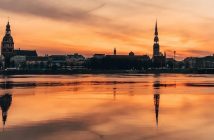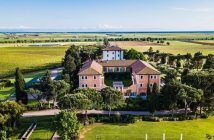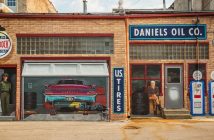Consummate traveller, aesthete and a man learned of many things – with the exception of horses – Harry Chapman laces his boots and ventures into Normandy, a land noted for its equestrianism…
The Greek historian Herodotus, an admirer of the Persians despite the hostility between the two countries, said that “they instruct their children from their fifth to the twentieth year in three things only; namely, in riding on horseback, in shooting with the bow, and in telling the truth.”
As an Anglo-Iranian the romanticism of the observation has long stuck (and it may be that the opportunity to quote it, however tenuous the connection, has long gestated). I confess that during my week-end in Normandy I saw little evidence of the widespread use of bow and arrow, nor can I say, with utter conviction, that all that was said to me was platinum truth (although having cross referenced much of it with my good friend Wikipedia, I can at least say that it had the outward appearance of truth. I can not vouch that every youth in the province is skilled in saddle and stirrup, however it is true to say that in Norman culture the horse has a special place, is very nearly revered. With its lush pasture, the hills of the region make perfect horse breeding ground; it is the most famous for this in all the country. Indeed there is something almost magic in the earth – six out of ten equine winners in the world come from Normandy.
Not being much of a horseman I knew none of this. The centre point of the trip was the seaside town of Deauville and as a film maker I did know that the town hosted what is arguably France’s most famous film festival after Cannes, the American film festival, or to give it its correct name, the Festival du Cinéma Américain, that year celebrating its fortieth anniversary. More to the point, the September festival was opening that weekend and I had a pass to attend.
It is easy for the English to dismiss Normandy. Too often, with the new fast ferries, is it seen as a whistlestop destination, a Continental depot for re-stocking on cheap drink and cigarettes. Yes, it has boules and baguettes and people who speak a foreign language (often a hindrance in English eyes) and, if one was to take the time to look about one, no shortage of the picturesque. Yet it lacks the one thing that the holidaying Anglo Saxon requires more over just about anything else – reliably hot and sunny weather. Once part of England (for a hundred and fifty years), Normandy is sometimes viewed as being too English to bother with, a place to be hustled through on a rush to warmer climes.
And this is a great pity.
On my visit to Normandy I was struck by a curious sensation – that what I was experiencing (seeing for the most part initially), was unfamiliarly familiar. There were the same species of trees – oak and beech – that I knew from the Weald in Sussex, but here the oak was more spreading, the beech taller and more straight backed, and the trees themselves were not isolated in narrow stands, but were allowed to range widely in open forests. Chesterton talked of the “rolling English road” made by the “rolling English drunkard” but here I found lanes as twisty and deep and hemmed in by hedgerows as any – if not more so – than in deep timbered Kent. The latter has its hops and beer but Normandy has its cider – a more powerful elixir still.
It’s true that the province has seen its share of industry – metallurgy, sugar refining, ceramics, ship building – and there are major urban settlements in the shape of Le Havre, Rouen and Cherbourg. Normandy is no remote rural idyll. And yet, perhaps aided by its size, it feels extremely bucolic. Whilst rural England is suffused with the ubiquitous red brick of Victorian and Edwardian house construction, in Normandy the mellower half timbered structure abounds for both domestic and farm buildings. So widespread is this style, especially in Upper Normandy, that this is what is referred to when people talk of the Normandy Style. It is a form which harks back; indeed many of the buildings are medieval. With roofing thatch from the fields, timber from the forests and infill daub from the ground, the typical Norman house feels like it has grown upwards out of the earth, rather than planted by the hand of man. William Cobbett, the nineteenth century champion of the English countryside, who eschewed the use of stone because of its skeletal longevity, would have approved. It is an organic environment whose human edifices might one day return to the land.
So how did this sleepy backwater get to play host to what is undeniably a big hitting international film festival which has attracted stars such as George Clooney and Sharon Stone and has boasted as president Roman Polanski, Neil Jordan and Jean-Paul Rappeneau? Well, for starters, and perhaps dessert, Normandy is no backwater. To the south east Paris lies a mere 130 kilometres from the provincial capital of Rouen. To the north and west lies the Channel and beyond this…the world. For Normandy possesses the outward-looking-ness of many a maritime region. The area which fell to the marauding Viking northmen in the tenth century (from which the name Norman is derived) itself spewed them out a century and a half later to conquer Britain and southern Italy. Five hundred years after this Norman explorers spearheaded the French colonisation of North America. Quebec City was founded by a Norman adventurer, as were Louisiana, Biloxi and New Orleans.
But it is not just opportunists and war mongers who have come in and out of Normandy. Art, too, has flourished. One of my favourite short story writers, Guy de Maupassant, was a native, as was Gustave Flaubert whose Madame Bovary, shocking for the time, was written in his study at Croisset. Marcel Proust famously used the towns of Deauville, Trouville and Cabourg as the basis for the resort of Balbec in A La Recherche du Temps Perdu whilst Ian Fleming, a visitor to Deauville in his youth, was thought to have used the town’s casino as inspiration for the fictional one in Casino Royale.
The land, which has produced so many noble race horses, seems to have been just as fertile for painters. Nicolas Pousin, Théodore Géricault and Millet were all Normans who took inspiration from the rich landscapes. But it was with the coming of the railway that the region was really opened up. The Impressionists came in droves (as well as proto-Impressionists Turner and Courbet.) The list reads like a who’s who of anyone who was anyone in late nineteenth century French painting circles – Pissaro, Sisley, Renoir, Gaugin, Seurat, Bonnard, Braque, Picasso.
It was Monet who led the charge. His house in Giverny became the setting for his famously evanescent series of paintings depicting water lilies and, with the help of several others, he helped to put the old port of Honfleur artistically on the map. I paid a flying visit to the place and can attest that apart from the bristling reflections on the aluminium masts and white sided fibre glass hulls of the boats in the harbour, it looked little changed for several centuries, In fact, so extraordinarily picturesque did it appear that I wouldn’t have been surprised to see stage hands turning up to move sections of the gaily coloured waterside terraces, revealing them to be two dimensional scenery.
The railway brought another species in even greater numbers – the Parisian haut monde. Before 1860 the town of Deauville was little more than a fishing hamlet stuck between marsh land and sand dunes. It was the Duc de Morny, half brother of Napolean III, who spotted the potential. The Victorian rage for the seaside was already in full swing. De Morny picked up vast swathes of what appeared useless land for a pittance. Visits by the emperor and the Imperial court to the region had already caught the eye of other speculators and the bourgeoisie. With the extension of the railway to the nearby town of Trouville which lay just across the river, de Morny was able to implement his plans. Around forty elaborate villas went up, a hotel, casino and a hippodrome for horse racing. Within five years the town’s popoulation had leaped from just over a hundred to well over a thousand and Deauville was established as one of the most fashionable seaside resorts in all of France.
Today the town is as desirable, if not more so. True, some of the old villas have seen better days, are boarded up and awaiting some maestro to magic them into a boutique hotel or to be scooped up by a passing fashion designer (Yves Saint Laurent had one here), but both the five star Normandy Barrière and Royal Hotels, built before the First World War, are still in fine fettle and were fully booked on our visit (much to my chagrin – I couldn’t get a room), the massive conference centre is booked three hundred days a year and the Deauville-La Touques Racecourse – just on the edge of town – was that week hosting the World Equestrian Games. In May 2011 the town even played host to the 37th G8 Summit.
It is an odd thing to see the fortunes of a fashionable seaside town so strongly continue. It is in marked contrast to England which saw a similar rush for all places maritime a century and a half ago but whose primary examples now are either crusty (Brighton), geriatric (Eastbourne), crusty and geriatric (Hastings) or downright tragic (Blackpool).
Although the construction of the two big Edwardian hotels – the sprawling Normandy and the squat Royal – altered the urban coastline of the centre of town when the former villas were demolished, these villas still dominate elsewhere and help to give the town some of its unique flavour. In any ordinary town in France there will be a handful of houses of such size which were once, or indeed still are, owned by the town’s chief citizenry. In Deauville though you have streets lined with them, all vying for attention, all trying to outdo the neighbours in elaborateness of design. And they truly are striking, Taking as their inspiration the Normandy Style with the organic half timbered walls, there is an injection too of high Gothic and even Alpine – a sort of Arts and Crafts run amok. There are steep gables, fancy finials and festoons of smaller rooftops at different heights and of a variety of shapes, some underhung with private balconies. Because the plots of land on which these villas stand are relatively small, the effect is compressed and sometimes bewildering. There is a theatricality there which reminded me of some of the districts of old Los Angeles where houses were thrown up in the 1920s and 30s in a variety of European styles. Here in Deauville they resembled versions of the mansion in The Addams Family. It was as though they and legions of their spooky relatives had inexplicably set up shop in a small town in northern France.
We visited one of them, the Villa Stassburger, in the soft intersection between town and countryside. Although it resembled, in its essentials, many of the other villas of the town, it was built after the initial wave of villa construction by Henri de Rothschild between 1907 and 1912, and curiously on a farm that had once belonged to Gustave Flaubert. In 1924 it was sold to the American billionaire Ralph Beaver Strassburger, a horse riding enthusiast and Francophone, and from whom the house now takes its name. His son donated it to the town in 1980 and since then it has operated as a museum. It has been kept very much as Strassburger furnished and decorated it in the thirties and forties so, oddly enough, for a house that is so locally famous, it reflects not the tastes of an Edwardian French aristocrat but a mid-century American whose palate veered towards the cosy and suburban, all comfy sofas and magnolia soft furnishings.
Across the dug harbour and the River Touques lies the fishing town of Trouville-sur-Mer, as differnet from Deauville as denim is from lace. The narrow jostling houses seem to stare across the water through gaping windows with customary French blue collar disdain. This was the France I was familiar with, with its densely packed terraces, dirty cobblestones, crumbling squares and busy cafés with rude white-aproned waiters charging about almost one to a customer. We ate at one of them and the food was good and rich and yet earthier than in the town’s Little Lord Fauntleroy brother across the sound. On the Sunday I saw a wedding party in black and white toiling up the steep hill to a vast Romanesque church in the delicate morning light, as the sea mist was lifting. Such were the ordinary but beautiful scenes in Trouville, if ever a tonic were needed for the rarefied promenades and plazas of Deauville.
Harry’s adventure in Normandy continues tomorrow as he attends the Festival du Cinéma Américain and gets closer to understanding the region’s affinity with the horse…




